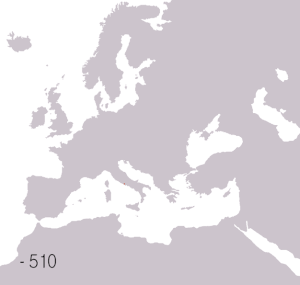
Ancient Rome

Territories of the Roman civilization from 510 BC to 480 AD:
In its approximately twelve centuries of existence, Roman civilization shifted from a monarchy to an aristocratic republic to an increasingly autocratic empire. Through conquest and assimilation, it came to dominate Southern Europe, Western Europe, Asia Minor, North Africa, parts of Northern Europe, and parts of Eastern Europe. Rome was preponderant throughout the Mediterranean region and was one of the most powerful entities of the ancient world. It is often grouped into "Classical Antiquity" together with ancient Greece, and their similar cultures and societies are known as the Greco-Roman world.
The Romans are still remembered today, including names such as Julius Caesar, Cicero, Augustus, etc. Ancient Roman society contributed greatly to government, law, politics, engineering, art, literature, architecture, technology, warfare, religion, language, society and more in the Western world. A civilization highly developed for its time, Rome professionalized and greatly expanded its military and created a system of government called res publica, the inspiration for modern republicssuch as the United States and France. It achieved impressive technological and architectural feats, such as the construction of an extensive system of aqueducts and roads, as well as large monuments, palaces, and public facilities.
By the end of the Republic, Rome had conquered the lands around the Mediterranean and beyond: its domain extended from the Atlantic to Judaea and from the mouth of the Rhine to North Africa. The Roman Empire emerged under the leadership of Augustus Caesar. Under Trajan, the Empire reached its territorial peak. Republican mores and traditions started to decline during the imperial period, with civil wars becoming a common ritual for a new emperor's rise.
Plagued by internal instability and attacked by various migrating peoples, the western part of the empire broke up into independent kingdoms in the 5th century. This splintering is a landmark historians use to divide the ancient period of universal history from the pre-mediaeval "Dark Ages" of Europe.
The Eastern Roman Empire survived this crisis and was governed from Constantinople after the division of the Empire. It comprised Greece, the Balkans, Asia Minor, Syria and Egypt. Despite the later loss of Syria and Egypt to the Arab-Islamic Empire, the Eastern Roman Empire continued for another millennium, until its remnants were finally annexed by the emerging Turkish Ottoman Empire. This eastern, Christian, medieval stage of the Empire is usually called the Byzantine Empire by historians.
From Wikipedia, the free encyclopedia





